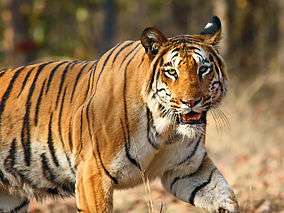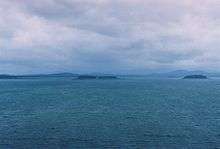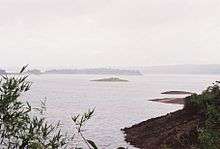Bhadra Wildlife Sanctuary
| Bhadra Wildlife Sanctuary Bhadra Tiger Reserve | |
|---|---|
| Wildlife Sanctuary | |
|
Tigers watching gaurs in Bhardra WLS | |
 Bhadra Wildlife Sanctuary Location in Karnataka, India | |
| Coordinates: 13°28′N 75°40′E / 13.467°N 75.667°ECoordinates: 13°28′N 75°40′E / 13.467°N 75.667°E | |
| Country |
|
| State | Karnataka |
| District | Chikkamagaluru District and Shivamogga district |
| Established | 1951[1] |
| Area | |
| • Total | 492.46 km2 (190.14 sq mi) |
| Elevation | 1,875 m (6,152 ft) |
| Languages | |
| • Official | Kannada |
| Time zone | IST (UTC+5:30) |
| Nearest city | Chikkamagaluru |
| IUCN category | IV |
| Governing body |
Government of India, MOEF, Project Tiger, Karnataka Forest Department |
| Precipitation | 2,100 millimetres (83 in) |
| Avg. summer temperature | 32 °C (90 °F) |
| Avg. winter temperature | 10 °C (50 °F) |
Bhadra Wildlife Sanctuary is a protected area and a Project Tiger, tiger reserve located 38 km (24 mi). Northwest of Chikkamagaluru town in Karnataka state, India.[2] Bhadra sanctuary has a wide range of flora and fauna and is a popular place for day outings. The 1,875 m (6,152 ft) above MSL Hebbe Giri is the highest peak in the sanctuary.
Geography
Bhadra sanctuary consists of two adjacent sections. The main western Lakkavalli-Muthodi section lies from 13˚22’ to 13˚47’ N latitude, 75˚29’ to 75˚45’ E longitude and the smaller eastern Bababudangiri section from 13˚30’ to 13˚33’ N latitude and 75˚44’ to 75˚47’ E longitude.
Elevation varies from 615 m (2,018 ft) to 1,875 m (6,152 ft) above MSL, the highest point being Kallathigiri on the eastern boundary.[3] The sanctuary is surrounded by the scenic hills and steep slopes of the Mullayanagiri, Hebbegiri, Gangegiri and Bababudangiri hills. 1,930 metres (6,330 ft) Mullayanagiri peak in the Baba Budan Giri Range near the southeast edge of the sanctuary is the highest peak between the Himalayas and the Nilgiris.
The 551 ft (168 m) high Hebbe Falls are in the eastern part of the sanctuary. The Manikyadhara Falls is located on the nearby sacred Baba Budan Giri Hill, The tributaries of the Bhadra river flow west through the sanctuary. The western border of the sanctuary abuts the Bhadra Reservoir and is part of its catchment area of 1,968 km2 (760 sq mi).[2]
Jagara and Sirivase are the villages located within the sanctuary. Bhadravathi, Tarikere, Birur are cities nearby the sanctuary. Larger metropolitan cities are well connected to Bhadravthi and birur by bus and rail. There is frequent local bus service from Bhadravathi to both Bhadra Dam and Bhadra WLS. The nearest airport is in Hubli, around 170 km (110 mi) from Bhadravathi.
Climate
Temperatures vary from 10˚ to 35°C and mean annual rainfall varies from 1200 mm to 2600 mm.[3]
History
The area was first declared as 'Jagara Valley Wildlife Sanctuary' in 1951 by the then government of Mysore covering an area of 77.45 km2 (29.90 sq mi). After a systematic survey of the flora and the fauna of the area and its surroundings, the area was extended to its present extent and renamed to Bhadra Wildlife Sanctuary in 1974.[2]
The Wildlife Sanctuary was declared as a Project Tiger Tiger Reserve in 1998. Bhadra is the first tiger reserve in the country to complete a successful village relocation program. The original relocation plan was introduced in 1974 and was implemented completely by 2002 when the 26 villages in the sanctuary were successfully relocated to M C Halli which is about 50 km (31 mi) from the Sanctuary.[4]
Biology and ecology
| Part of a series on the |
| Wildlife of India |
|---|
 |
|
Biodiversity |
|
|
Organisations
|
|
Related topics |
|
Bhadra Wildlife Sanctuary is a biodiversity hotspot. Most of the area consists of dry deciduous forest, moist deciduous forest and semi evergreen forests.[5] Elevations ranging from 615 m (2,018 ft) to 1,875 m (6,152 ft) above MSL allows a variety of ecotypes including the unique shola forest/ mountain grasslands complex at Bababudan Giri and other patches higher than 1,400 m (4,600 ft) above MSL.[3] Phenology has been defined as the study of cyclical biological events. In plants, this can include leafing, flowering and fruiting phenophases. Phenological studies were on going to know the biology of tree species (9,10,11,12)
Flora
Bhadra supports more than 120 plant species. One typical 2 ha (4.9 acres) of tropical dry deciduous forest had 46 species, 37 genera and 24 families. Combretaceae was the most abundant family in the forest. Indigoberry (Randia dumetorum) was the dominant species.[5]
Throughout the sanctuary the common species include crepe myrtle (lanceolata), kadam, thaasal (tiliaefolia), simpoh (pentagyna), teak, kindal, Indian-laurel, rosewood, Indian kino tree, white teak, fig tree, mangosteen, Kydia calycina, indigo, toddy palm, Ceylon oak, jalari, jamba tree, axlewood, slow match tree, thorny bamboo and clumping bamboo.[6]
It is the habitat of valuable teak and rosewood. Other commercial timber in the sanctuary includes: mathi, honne, Nandi, tadasalu and kindal. There is also bamboo and several types of medicinal plants.[2]
Fauna

Mammals
An estimated 33 tigers are found in Bhadra. Other mammals in the sanctuary include elephant, gaur, sloth bear, wild boar, black leopard, jungle cat, jackal, wild dog, sambar, spotted deer, barking deer, mouse deer, common langur, bonnet macaque, slender loris, small Indian civet, common palm civet, pangolin, porcupine, flying squirrel and the Malabar giant squirrel.[4][6]
Small carnivores found in the Bhadra Wildlife Sanctuary include leopard cat, rusty-spotted cat, ruddy mongoose, stripe-necked mongoose and otters.[7]
| Tiger | 25 | 33 |
| Leopard | 22 | 21 |
| Elephant | 161 | 203 |
| Guar | 139 | 186 |
| Chital | 780 | |
| Sambar | 518 | |
| Bonnet macaque | 248 | |
| Wild boar | 470 | |
| Muntjac | 749 |
Reptiles
Some of the reptiles commonly sighted in this park are common vine snake, king cobra, common cobra, Russell's viper, bamboo pit viper, rat snake, olive keelback, common wolf snake, common Indian monitor, Draco or gliding lizards and marsh crocodiles.[6]
Birds
Bhadra sanctuary has more than 300 species of birds, some endemic to this region and some migratory.[4] Some of the species are grey junglefowl, red spurfowl, painted bush quail, emerald dove, southern green imperial pigeon, great black woodpecker, Malabar parakeet, hill myna, ruby-throated bulbul, shama, Malabar trogon, Malabar whistling thrush, four species of hornbill and racquet-tailed drongo.
Butterflies
Some of the butterflies in Bhadra sanctuary are yamfly, baronet, crimson rose butterfly, southern birdwing, tailed jay, great orange tip, bamboo tree brown, and blue pansy.
Threats
A growing threat is human population in the villages close to the sanctuary and encroachment in areas surrounding Bhadra Wildlife Reserve. Grazing by the thousands of cattle that belong to the villagers are a threat. Livestock carry diseases like foot and mouth disease to the herbivours in the park. During the 1989-99 time period, rinderpest wiped out most of the gaur population, which numbered more than a thousand, reducing the population to its present numbers. With proactive programs of inoculating local cattle, the population of gaur is again on the rise.
Another concern due to closeness of the population is procurement of non-timber forest products for commercial purposes and the procurement of timber for firewood. These affect the health of the forest in a long run. The other large threats are fishing and illegal poaching of wild animals.[8]
Management practises of the forest department are habitat improvement, boundary consolidation, protection against poaching and fires, and infrastructure development. However, operating funds are insufficient and often delayed and the sanctuary management is understaffed. There are problems with frequent fires which adversely affect the habitat and biodiversity of Bhadra. Timber smuggling of valuable trees is a big problem.[1]
Tunga-Bhadra Lift Irrigation Project promises to bring water to the rainshadow areas of Chikmagalur district by transferring water from the Tunga River to the Bhadra River, however this poses a threat of disturbance to the natural habitat of Bhadra sanctuary.
Gallery
-
_at_Bhadra_wildlife_sanctuary.jpg)
Bull gaur at Bhadra WLS
-

Bhadra WLS located south of Bhadra dam
-

Lemon pansy butterflies
-
Blue winged Malabar parakeet roost
-
A view of a Bhadra WLS
-

Rose ringed parakeet or common parrot at Bhadra WLS
-

River tern nestling learning to fly, Bhadra WLS
-

Common Baron butterfly at Bhadra WLS
-

Bhadra Reservoir and River Tern Islands
-

Bhadra Reservoir with River Tern Islands
References
- 1 2 Fact sheet of Bhadra Tiger Reserve, Wildlife Protection Society of India, retrieved 2012-02-01
- 1 2 3 4 5 "bhadra on project tiger". Archived from the original on 2011-01-06. Retrieved 2011-03-09.
- 1 2 3 "About The Sanctuary", Sanctuaries - Bhadra Wildlife Sanctuary, Karnataka State Wildlife Board, 2011, retrieved 2012-02-01
- 1 2 3 k karanth, krithi, Economic and Political Weekly (PDF), retrieved 2011-03-12
- 1 2 y l, Krishnamurthy (2010), "Vegetation structure and floristic composition of a tropical dry deciduous forest in Bhadra Wildlife Sanctuary, Karnataka, India" (PDF), Tropical Ecology, International Society for Tropical Ecology, 51(2), pp. 235–246, ISSN 0564-3295
- 1 2 3 "Sanctuary - Flora and Fauna", Sanctuaries - Bhadra Wildlife Sanctuary, Karnataka State Wildlife Board, 2011, retrieved 2012-02-01
- ↑ Kumar, H N; Mewa Singh (November 2006). "Small Carnivores Of Karnataka: Distribution And Sight Records". Journal of the Bombay Natural History Society. Bombay Natural History Society. 104: 155–162.
- ↑ D karanth, krithi, Forest use and human-wildlife conflicts in Bhadra Wildlife Sanctuary, Karnataka, India (PDF), retrieved 2011-03-12
9.Nanda, A, Krishna Murthy,Y.L and Suresh, H.S. (2013). Canopy trees phenology in a tropical dry deciduous and evergreen forest of Bhadra wildlife sanctuary, Karnataka, India. African journal of plant science 7(5): 170-175. 10.Nanda, A, Prakasha, H.M. Krishnamurthy, Y.L. and Suresh, H.S. (2012). Leafing phenology of canopy, under-storey trees and seasonality in a tropical evergreen forest of bhadra wildlife sanctuary, Karnataka, southern India. Indian Journal of Forestry, vol. 35 (4): 457-462. 11.Nanda, A, Prakasha, H.M. Krishnamurthy, Y.L. and Suresh, H.S. (2011). Phenology of leaf flushing, flower initiation and fruit maturation in dry deciduous and evergreen forests of Bhadra Wildlife Sanctuary, Karnataka, southern India. Our Nature, 9: 89-99. 12.Nanda, A, Prakasha, H.M. Krishnamurthy, Y.L. and Suresh, H.S. (2010). Phenology of a tropical dry forest: study from Bhadra Wildlife Sanctuary, Karnataka, peninsular India. Indian Journal of Forestry, vol. 33 (2): 167-172
Other links
| Wikimedia Commons has media related to Bhadra Wildlife Sanctuary. |
- A captivating image of 2 tigers staring at an adult Gaur in Bhadra Tiger Reserve
- 'Wildlifing in Bhadra' A travel story on Bhadra Tiger Reserve, published in Sunday Herald (Deccan Herald), Bangalore, July 1, 2001.
- 'End of conflict' A story on the once man-animal conflict in Bhadra sanctuary.
- Excellent images from Bhadra Tiger Reserve
- WildLife conservation in Bhadra
